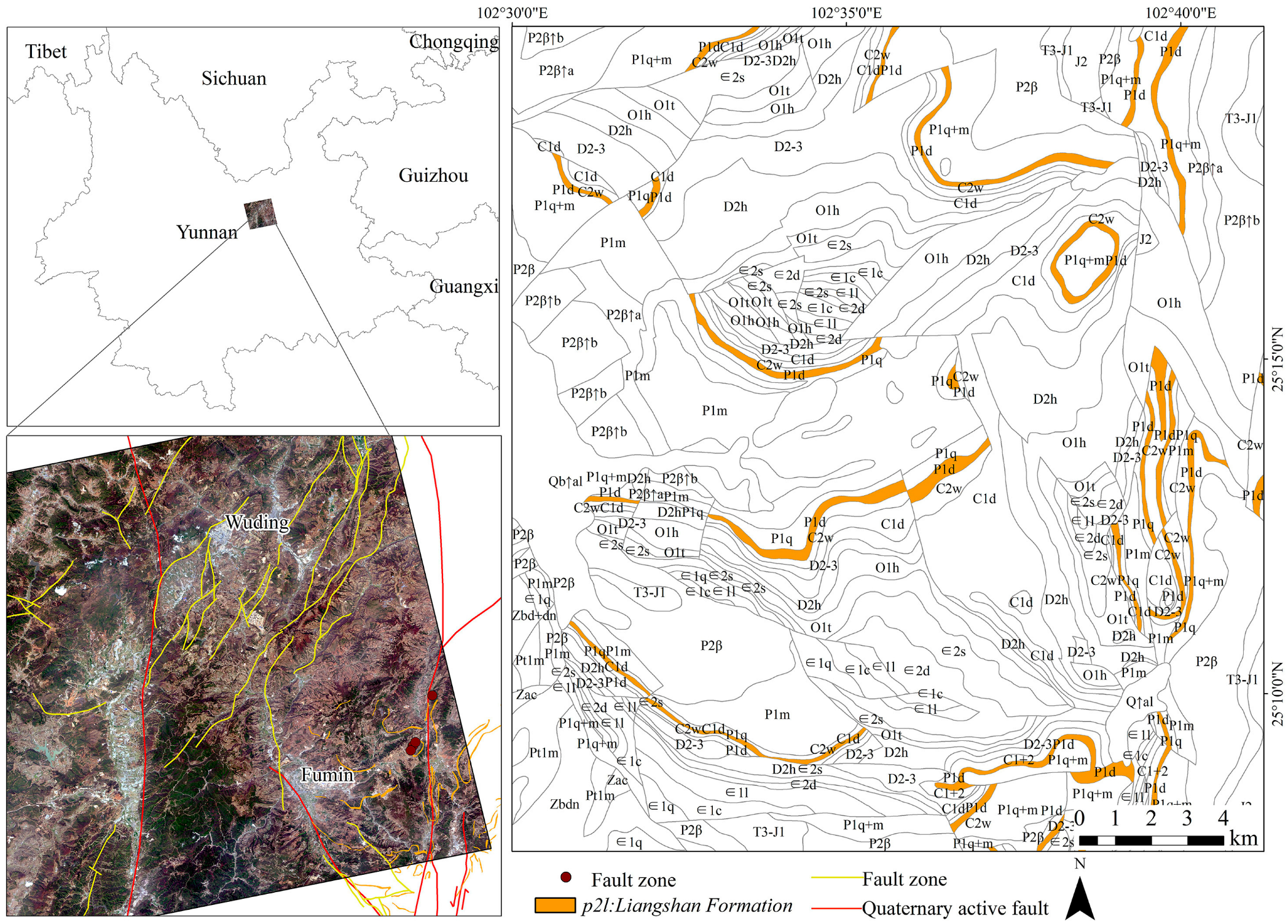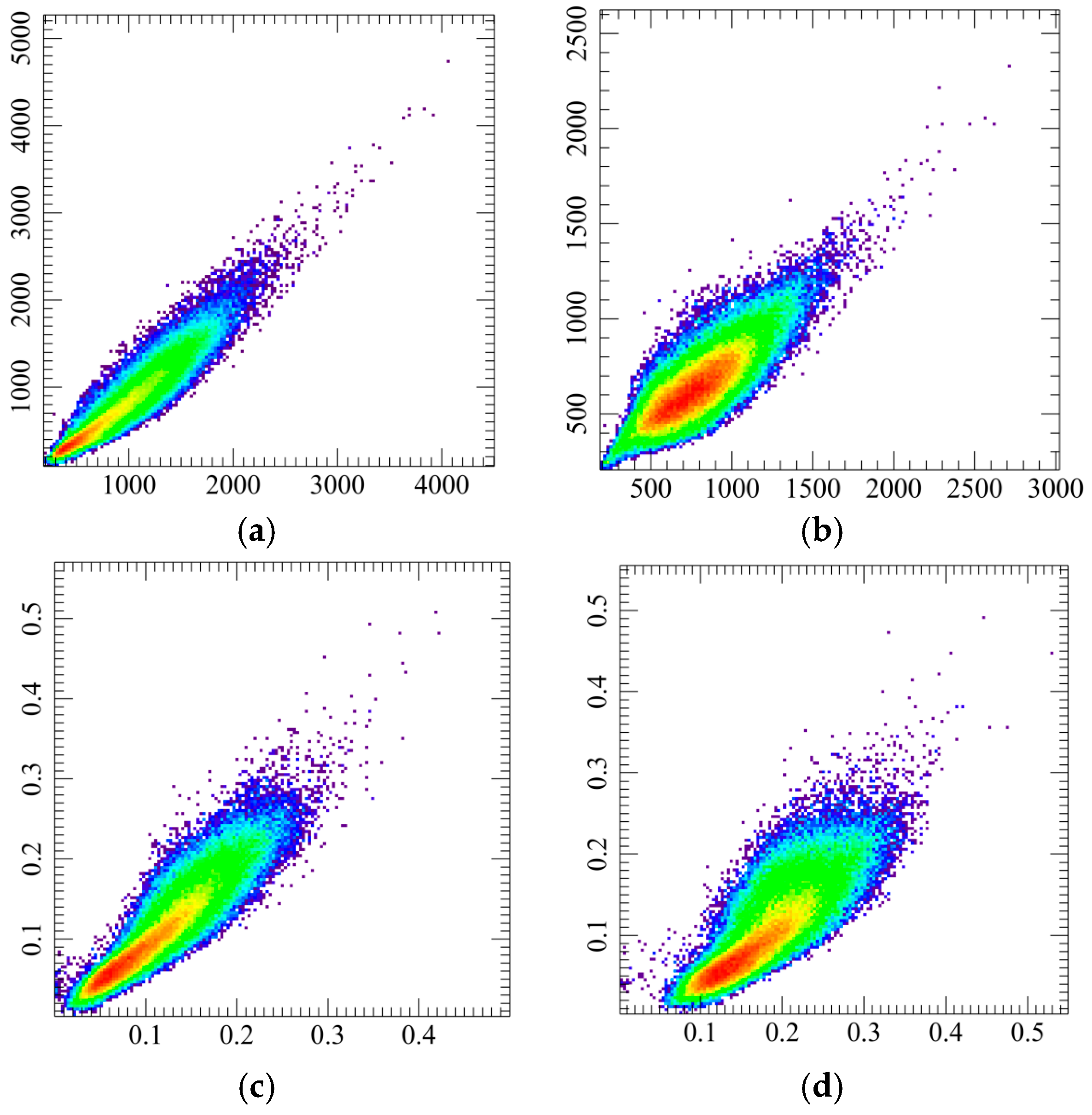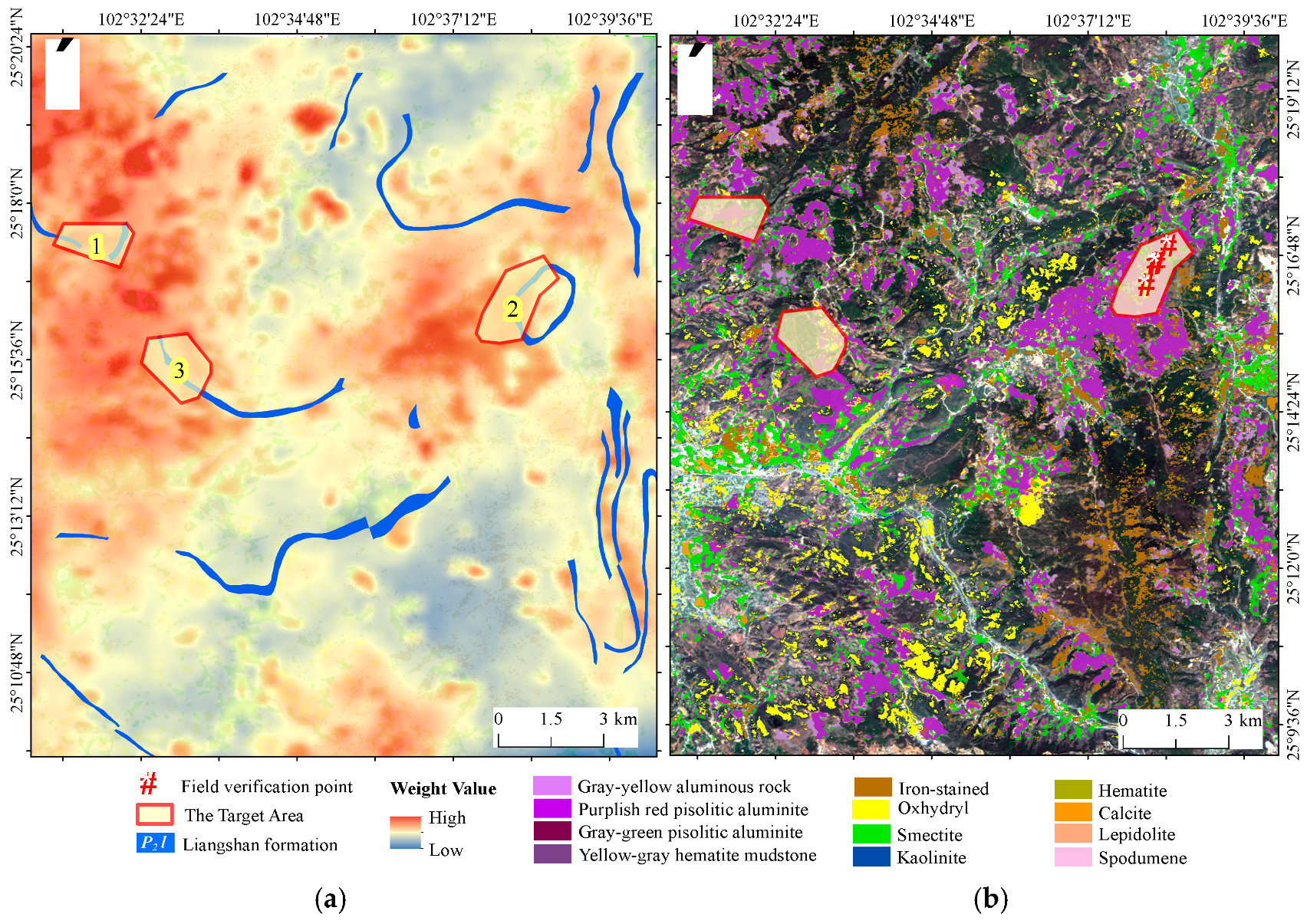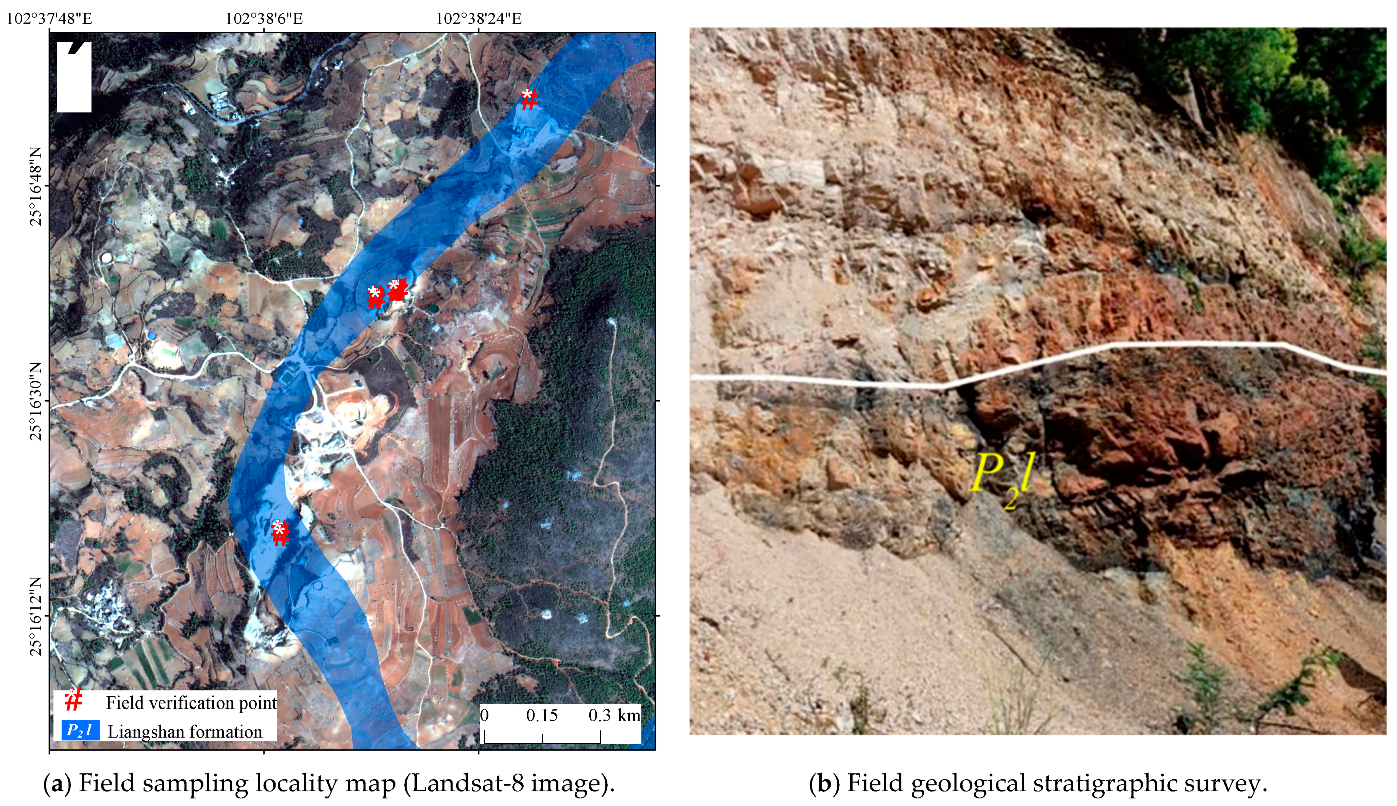Environmentally Sustainable Lithium Exploration: A Multi-Source Remote Sensing and Comprehensive Analysis Approach for Clay-Type Deposits in Central Yunnan, China
Abstract
1. Introduction
2. Materials and Methods
2.1. Geological Setting of the Area
2.2. Data and Preprocessing
2.2.1. Remote Sensing Data
- (1)
- GF-3 QPSI
- (2)
- GF-5B AHSI
- (3)
- Landsat 8 OLI
2.2.2. Field Sampling Data and Preprocessing
- (1)
- Mineral Specimen Collection and Analysis
- (2)
- Rock Sample Data Collection
2.2.3. Spectral Collection of Lithium-Rich Minerals
2.3. Vegetation Suppression
2.4. Alteration Information Extraction
2.4.1. Extraction of Mineralization and Alteration Anomalies
2.4.2. Hyperspectral Hourglass Method
2.5. Structural Interpretation
2.6. Comprehensive Analysis of Multifactorial Information
- (1)
- Normalization: Each layer was normalized using the following equation:
- (2)
- Kernel Density Analysis: This highlighted the spatial clustering patterns of features related to mineralization.
- (3)
- PCA: This integrated information from six layers (hydroxyl, iron staining, minerals, lithology, structures, and stratigraphy) to enhance extraction of mineral and alteration features. The prospecting potential score, S, was calculated as follows:
- (4)
- Threshold-Based Targeting: High-potential zones were identified by defining thresholds for S.
3. Results
3.1. Vegetation Suppression Effects
3.2. Alteration Anomaly Extraction
3.3. Structural Interpretation of Remote Sensing Data
3.4. Comprehensive Analysis of Multiple Information Sources and Optimization
3.5. Field Verification
4. Discussion
- (1)
- Validation and Application of Multi-source Remote Sensing in Collaborative Mineral Exploration. A hierarchical anomaly extraction strategy was developed by integrating diverse data types and techniques: PCA-based detection of hydroxyl and iron-staining anomalies, spectral hourglass processing for precise identification of lithium-bearing minerals such as montmorillonite and illite, and radar image decomposition to enhance the detection of concealed structural features. The synergistic analysis of multispectral, hyperspectral, and radar data—complemented by detailed field validation—demonstrated strong spatial consistency between predicted anomalies and measured Li2O content in claystone layers, thereby validating the method’s reliability in rugged, vegetated terrain.
- (2)
- Multidimensional Weighted Comprehensive Analysis. We propose a preprocessing protocol-kernel density-normalization joint preprocessing protocol for Multi informational layers, including hydroxyl, iron-staining, mineralogy, lithology, and structural features. This protocol was integrated with expert-driven dynamic weighting to develop a robust, hierarchical model for target zone delineation.
- (3)
- Future research should focus on three key areas to further advance this field:
5. Conclusions
- (1)
- The integration of GF-3 QPSI SAR, GF-5B hyperspectral, and Landsat-8 OLI datasets proved highly effective in identifying and delineating lithium-rich mineralization zones. By combining these diverse data sources, our approach significantly improves the accuracy and reliability of exploration efforts, making it a powerful tool for detecting mineralization in complex environments.
- (2)
- The reclassification–kernel density–normalization preprocessing protocol, combined with expert-driven dynamic weighting, offers a flexible and adaptable approach to target zone delineation. Field validation confirmed that the hierarchical anomaly extraction method reliably predicts the presence of Li2O in claystone layers, ensuring that the exploration process is both precise and efficient.
- (3)
- This approach aligns with the goals of green mining, reducing environmental impact by promoting data-driven exploration methods that minimize the need for intrusive, destructive practices. It sets out new ideas for sustainable and environmentally responsible exploration, contributing to the long-term viability of clay-type lithium deposits and supporting the global shift toward renewable energy sources.
Author Contributions
Funding
Institutional Review Board Statement
Informed Consent Statement
Data Availability Statement
Acknowledgments
Conflicts of Interest
References
- Liu, X.; Wang, C.L.; Liu, X.L.; Liu, D.H.; Yan, K.; Liu, S.H.; Liu, Y.T. Main Types, Distribution, Development and Utilization of Lithium Deposits in China. Geol. China 2024, 51, 811–832. [Google Scholar] [CrossRef]
- Schulz, K.J.; DeYoung, J.H.; Seal, R.R.; Bradley, D.C. Critical Mineral Resources of the United States: Economic and Environmental Geology and Prospects for Future Supply; U.S. Geological Survey Professional Paper 1802; U.S. Geological Survey: Reston, VA, USA, 2017. [Google Scholar] [CrossRef]
- Wen, H.J.; Luo, C.G.; Du, S.J.; Yu, W.X.; Gu, H.N.; Ling, K.Y.; Cui, Y.; Li, Y.; Yang, J.H. Carbonate-Hosted Clay-Type Lithium Deposit and Its Prospecting Significance. Chin. Sci. Bull. 2020, 65, 53–59. [Google Scholar] [CrossRef]
- Zhang, Q.D.; Li, D.Z.; Li, Z.W.; Wang, D.H.; Yu, Y.F.; Zhu, X.Q.; Cai, Q.Y.; Li, M. Geochemical Characteristics and Genesis of Lithium-Rich Clay Rocks in the Pudi Area of Northwestern Guizhou. Earth Sci. Front. 2024, 31, 258–280. [Google Scholar]
- Xiao, B.; Gong, D.X.; Tian, E.Y.; Yu, L.M.; Chen, C.H.; Huang, C.C.; Zhang, J.; Zou, H. Study on Metallogenic Characteristics of Clay-Type Lithium Deposits in Guizhou Province. Geol. Rev. 2024, 70 (Suppl. S1), 73. [Google Scholar] [CrossRef]
- Chen, X.; Tian, Y.G.; Cheng, J.L.; Li, W.Z.; Geng, Q.W.; Jiang, J.M.; Li, H.; Wu, F. Lithium Enrichment in the Clay Rocks of Liangshan Formation and Prospecting Prediction in Central Yunnan Province. Geol. Resour. 2023, 32, 705–712. [Google Scholar] [CrossRef]
- Du, W.Y.; Li, Y.M.; Zhou, B.; Fan, C.; Zeng, X.H.; Liu, J.; Liu, S.X.; Liu, L.; Liu, W.W.; Wei, S.H.; et al. Mineralization Characteristics and Prospecting Potential of Clay-Type Lithium in Southwestern Hubei. Resour. Environ. Eng. 2022, 36, 562–571. [Google Scholar] [CrossRef]
- Tong, Q.X.; Zhang, B.; Zhang, L.F. Current Progress of Hyperspectral Remote Sensing in China. J. Remote Sens. 2016, 20, 689–707. [Google Scholar] [CrossRef]
- Gürbüz, A.; Gürbüz, E. Remote Sensing Approaches for Mapping Quaternary Deposits: A Synthesis. Phys. Chem. Earth Parts A/B/C 2022, 126, 103128. [Google Scholar] [CrossRef]
- Cardoso-Fernandes, J.; Teodoro, A.C.; Lima, A. Remote Sensing Data in Lithium (Li) Exploration: A New Approach for the Detection of Li-Bearing Pegmatites. Int. J. Appl. Earth Obs. Geoinf. 2019, 76, 10–25. [Google Scholar] [CrossRef]
- Romppanen, S.; Pölönen, I.; Häkkänen, H.; Kaski, S. Optimization of Spodumene Identification by Statistical Approach for Laser-Induced Breakdown Spectroscopy Data of Lithium Pegmatite Ores. Appl. Spectrosc. Rev. 2023, 58, 297–317. [Google Scholar] [CrossRef]
- Jiang, G.; Zhou, K.F.; Wang, J.L.; Bai, Y.; Sun, G.Q.; Wang, W. Identification of Lithium-Beryllium Granitic Pegmatites Based on Deep Learning. Earth Sci. Front. 2023, 30, 185–196. [Google Scholar] [CrossRef]
- Li, S.Y.; Xiang, J.; Yan, X.; Chen, J. Research on the Monitoring Method of Lithium Mineral Capacity of Salt Lakes Based on Satellite Remote Sensing: A Case Study of Atacama Salt Lake. China Min. Mag. 2025, 34, 107–115. [Google Scholar]
- Soliman, N.; Salem, S.; Attwa, M.; El Bastawesey, M. Mapping Potential Salt Minerals over Wadi El Natrun Saline Lakes, Egypt, Using Remote Sensing and Geophysical Techniques. Arab. J. Geosci. 2021, 14, 1987. [Google Scholar] [CrossRef]
- Cui, Y.; Wen, H.J.; Yu, W.X.; Luo, C.G.; Du, S.J.; Ling, K.Y.; Xu, F.; Yang, J.H. Study on the Occurrence State and Enrichment Mechanism of Lithium in Lithium-Rich Clay Rock Series of the Daoshitou Formation of Lower Permian in Central Yunnan. Acta Petrol. Sin. 2022, 38, 2080–2094. [Google Scholar] [CrossRef]
- Yin, C.T. Yunnan Dianzhong Clay-Type Lithium Deposit Remote Sensing Extraction and Quantitative Inversion of Lithium Content. Ph.D. Thesis, Chang’an University, Xi’an, China, 2024. [Google Scholar] [CrossRef]
- Tang, S.L.; Cao, J.N.; Wang, K. Remote Sensing Mineralization Alteration Information Extraction Based on PCA, Multilevel Segment Method, and SVM. Natl. Remote Sens. Bull. 2021, 25, 653–664. [Google Scholar] [CrossRef]
- Kitchat, K.; Chiu, Y.-L.; Lin, Y.-C.; Sun, M.-T.; Wada, T.; Sakai, K.; Ku, W.-S.; Wu, S.-C.; Jeng, A.A.-K.; Liu, C.-H. PedCross: Pedestrian Crossing Prediction for Auto-Driving Bus. IEEE Trans. Intell. Transp. Syst. 2024, 25, 8730–8740. [Google Scholar] [CrossRef]
- Ye, B. Remote Sensing Ore-Indicating Information Extraction and Metallogenic Prediction of Granitic Pegmatite-Type Lithium Deposits: A Case Study of Dahongliutan Area, Xinjiang. Ph.D. Thesis, China University of Geosciences (Beijing), Beijing, China, 2022. [Google Scholar] [CrossRef]
- Cardoso-Fernandes, J.; Teodoro, A.C.; Lima, A.; Roda-Robles, E. Semi-Automatization of Support Vector Machines to Map Lithium (Li) Bearing Pegmatites. Remote Sens. 2020, 12, 2319. [Google Scholar] [CrossRef]
- Shirmard, H.; Farahbakhsh, E.; Müller, R.D.; Chandra, R. A Review of Machine Learning in Processing Remote Sensing Data for Mineral Exploration. Remote Sens. Environ. 2022, 268, 112750. [Google Scholar] [CrossRef]
- Li, Y.; Yuan, X.; Gan, S.; Mu, C.; Liu, Q.; Wang, Y. Hyperspectral Inversion of Li2O Content in Clay Lithium Ore Cores Based on FOD and GA-XGBoost. Int. J. Remote Sens. 2025, 46, 2984–3003. [Google Scholar] [CrossRef]
- Feng, X.; Tian, A.; Fu, C. Hyperspectral Prediction Model of Soil Cu Content Based on WOA-SPA Algorithm. Int. J. Remote Sens. 2024, 45, 6408–6424. [Google Scholar] [CrossRef]
- Carranza, E.J.M.; Laborte, A.G. Data-Driven Predictive Mapping of Gold Prospectivity, Baguio District, Philippines: Application of Random Forests Algorithm. Ore Geol. Rev. 2015, 71, 777–787. [Google Scholar] [CrossRef]
- Hegab, M.A.E.-R. Mineral Exploration and Environmental Impact Assessment in the Jabal Hamadat Area, Central Eastern Desert, Egypt, Using Remote Sensing and Airborne Radiometric Data. Sci. Rep. 2024, 14, 21986. [Google Scholar] [CrossRef] [PubMed]
- Hajaj, S.; El Harti, A.; Jellouli, A. Assessment of Hyperspectral, Multispectral, Radar, and Digital Elevation Model Data in Structural Lineaments Mapping: A Case Study from Ameln Valley Shear Zone, Western Anti-Atlas Morocco. Remote Sens. Appl. Soc. Environ. 2022, 27, 100819. [Google Scholar] [CrossRef]
- Jellouli, A.; El Harti, A.; Adiri, Z.; Chakouri, M.; El Hachimi, J.; Bachaoui, E.M. Application of Optical and Radar Satellite Images for Mapping Tectonic Lineaments in Kerdous Inlier of the Anti-Atlas Belt, Morocco. Remote Sens. Appl. Soc. Environ. 2021, 22, 100509. [Google Scholar] [CrossRef]
- Feng, Y.; Dai, J.; Bai, L.; Wu, C. Prospecting Prediction for the Yulong Metallogenic Belt in Tibet Based on Remote Sensing Alteration Information and Structural Interpretation. Remote Sens. 2024, 16, 1343. [Google Scholar] [CrossRef]
- Cheng, Y.M.; Zhai, X.; Li, W.Q.; Yang, X.; Zhao, Y.L.; Cui, Y.L.; Zhai, J.W.; Zheng, X.J. A Major Breakthrough in Prospecting of Carbonate-Hosted Clay-Type Lithium Deposit in Anning Area, Yunnan Province. Miner. Explor. 2024, 15, 161–163. [Google Scholar] [CrossRef]
- Tan, H.J.; Qiu, K.F.; Liu, H.C.; Zhang, P.C.; Fu, J.N.; Wang, R.; Luo, J.X.; Shi, Y.M. Alteration Characteristics of Wall Rocks in the Liba Orogenic Gold Deposit, West Qinling: Based on Information Extraction from GF-5B Spaceborne Hyperspectral Data. Acta Petrol. Sin. 2024, 40, 1784–1800. [Google Scholar] [CrossRef]
- Wang, X.; Wang, H.P.; Wang, R.; Wu, Z.J.; Gao, F.L.; Kang, N.; Wan, F.L.; Wang, Y.L.; Yang, H.; Liu, J. Geological Interpretation of Remote Sensing Images Based on Data Fusion of GF-2 and Landsat 8: A Case Study of the Wafangdian 1:50,000 Quadrangle Map. Geol. Rev. 2019, 65, 918–928. [Google Scholar] [CrossRef]
- Bai, L.Y.; Dai, J.J.; Wang, N.; Li, B.L.; Liu, Z.B.; Li, Z.J.; Chen, W. Extraction of Mineral Alteration Information and Mineralization Prospecting Analysis Based on GF-5 Hyperspectral in Zhule-Mangla, Tibet. Geol. China 2024, 51, 995–1007. [Google Scholar] [CrossRef]
- Tu, K.; Wen, Q.; Shen, H.; Yu, F.; Gu, X.Z. A New Method of Structural Interpretation in Meadow Covering Based on GF-3 Pol-SAR Images. J. Remote Sens. 2019, 23, 243–251. [Google Scholar] [CrossRef]
- China Geological Survey. Analysis of Rocks and Minerals, 4th ed.; Geological Publishing House: Beijing, China, 2011. [Google Scholar]
- GB/T 17413.3-2010; General Administration of Quality Supervision, Inspection and Quarantine of China & Standardization Administration of China. Chemical Analysis Methods for Lithium Ores—Part 3: Determination of Lithium Content. Standards Press of China: Beijing, China, 2010.
- Zhang, Q.D.; Jiang, S.Y.; Wang, W.; Ge, W. Current Status and Prospect of Researches on Sediment-Hosted Li Deposits in Bauxite Formations and Coal-Bearing Strata in China. Bull. Miner. Petrol. Geochem. 2024, 43, 90–101. [Google Scholar] [CrossRef]
- Zhao, H.Q.; Gao, W.; Yang, T.Y.; Liu, S.; Zhao, X.S. Alteration Information Extraction Based on Multispectral Differential Vegetation Suppression Method. J. Min. Sci. Technol. 2020, 5, 364–373. [Google Scholar] [CrossRef]
- Yu, L.; Porwal, A.; Holden, E.J.; Dentith, M.C. Suppression of Vegetation in Multispectral Remote Sensing Images. Int. J. Remote Sens. 2011, 32, 7343–7357. [Google Scholar] [CrossRef]











| Satellite Sensor | Data Time | Spatial Resolution/m | Spectral Range, Wavelength/μm | Band | Width/km | Data Sources |
|---|---|---|---|---|---|---|
| GF-3 QPSI [33] | 10 March 2022 24 March 2024 | 8 m | Band C | -- | 30 | https://www.cpeos.org.cn/home |
| GF-5B AHSI [30] | 21 March 2024 | 30 m | 0.38~2.5 μm: VNIR 0.38–1.025, SWIR 1.01–2.5 | 330 | 60 | |
| Landsat-8 OLI [28] | 29 May 2024 | Pan, 15 m Other, 30 m | Coastal 0.43–0.45; Blue 0.45–0.51; Green 0.53–0.59; Red 0.64–0.67; NIR 0.85–0.88; SWIR1 1.58–1.65; SWIR2 2.11–2.29; Pan 0.50–0.68; Cirrus 1.36–1.38 | 9 | 90 | https://www.cpeos.org.cn/home |
| Rock Type | Li2O Content | Sample Photo | Rock Type | Li2O Content | Sample Photo |
|---|---|---|---|---|---|
| Gray-yellow aluminous rock | 0.68% |  | Gray-green pisolitic aluminite | 0.12% |  |
| Purplish red pisolitic aluminite | 0.30% |  | Yellow-gray hematite mudstone | 0.14% |  |
| Minerals | Absorption Peak Positions |
|---|---|
| Smectite | 1.412, 1.906, 2.205, 2.215 |
| Kaolinite | 1.400, 2.205–2.160 |
| Hematite | 2.297 |
| Calcite | 2.338 |
| Lepidolite | 1.400, 2.194, 2.345 |
| Spodumene | 1.905, 2.205 |
| Eigenvectors | Iron Alteration | Hydroxyl Alteration | ||||||
|---|---|---|---|---|---|---|---|---|
| Band 1 | Band 2 | Band 4 | Band 5 | Band 2 | Band 5 | Band 6 | Band 7 | |
| PC1 | −0.1583 | −0.1797 | −0.3505 | −0.9054 | 0.1324 | 0.7066 | 0.5993 | 0.3521 |
| PC2 | −0.5812 | −0.5811 | −0.4235 | 0.3809 | 0.1951 | 0.6690 | −0.6171 | −0.3655 |
| PC3 | −0.4211 | −0.3082 | 0.8322 | −0.1874 | 0.7088 | −0.1669 | −0.3168 | 0.6077 |
| PC4 | −0.6781 | 0.7315 | −0.0719 | 0.0013 | 0.6648 | −0.1590 | 0.3996 | −0.6108 |
| Mineral Type | Standard Deviation | k Values | Threshold Range |
|---|---|---|---|
| Hydroxyl | 49.87 | 1 | 99.75 |
| 1.5 | 124.68 | ||
| 2 | 149.62 | ||
| Iron-Stained | 9.06 | 1.5 | 13.59 |
| 2.5 | 22.66 |
| Parameter | Significance | Unit | Description | Value |
|---|---|---|---|---|
| Radi | Filter Radius | Pixel | Canny edge detection, gradient calculation of gaussian filter radius | 12 |
| Gthr | Edge Gradient Threshold | -- | The minimum gradient value of edge detection; the greater the value, the fewer edges in the image | 50 |
| Lthr | Curve Length Threshold | Pixel | Considered the minimum length of a linear construction | 25 |
| Fthr | Line Fitting Threshold | -- | The maximum error allowed when a line segment is fitted to form a linear construct | 3 |
| Athr | Angle Difference Threshold | Pixel | Defines the angle that cannot be exceeded between the two multisegment lines to be joined. When the angle is greater than the value between 2 lines, do not connect operations | 20 |
| Dthr | Connection Distance Threshold | Pixel | Specifies the maximum distance between two line segments to be connected. If the distance exceeds this value, the connection is not connected | 1 |
| Filtering Direction | N0° (N-S) | N45° (NE-SW) | N90° (E-W) | N135° (NW-SE) |
|---|---|---|---|---|
| Num | 78,646 | 74,483 | 74,483 | 74,483 |
| Max_Length | 4474.410842 | 5841.818096 | 5841.818096 | 5841.818096 |
| Min_Length | 139.4115978 | 137.3552379 | 137.3552379 | 137.3552379 |
| Mean | 298.9301953 | 294.7153861 | 294.7153861 | 294.7153861 |
| Sum | 23,509,664.14 | 21,951,286.1 | 21,951,286.1 | 21,951,286.1 |
| Evidence Layer | Score | Weight (%) | |
|---|---|---|---|
| Hydroxyl alteration (normal diagnostic indicator) | Low | 1 | 10 |
| Middle | 2 | ||
| High | 3 | ||
| Iron stain alteration (normal diagnostic indicator) | Low | 1 | 10 |
| Middle | 2 | ||
| High | 3 | ||
| Mineral alteration (significant diagnostic indicator) | Smectite | 1 | 30 |
| Kaolinite | 1 | ||
| Hematite | 1 | ||
| Calcite | 1 | ||
| Lepidolite | 1 | ||
| Spodumene | 1 | ||
| Rock alteration (significant diagnostic indicator, the analytical score represents the measured Li2O concentration within rock samples) | Gray-yellow aluminous rock | 0.68 | 30 |
| Purplish red pisolitic aluminite | 0.30 | ||
| Gray-green pisolitic aluminite | 0.12 | ||
| Yellow-gray hematite mudstone | 0.14 | ||
| Structural line * | 1 | 20 | |
Disclaimer/Publisher’s Note: The statements, opinions and data contained in all publications are solely those of the individual author(s) and contributor(s) and not of MDPI and/or the editor(s). MDPI and/or the editor(s) disclaim responsibility for any injury to people or property resulting from any ideas, methods, instructions or products referred to in the content. |
© 2025 by the authors. Licensee MDPI, Basel, Switzerland. This article is an open access article distributed under the terms and conditions of the Creative Commons Attribution (CC BY) license (https://creativecommons.org/licenses/by/4.0/).
Share and Cite
Li, Y.; Yuan, X.; Gan, S.; Mu, C.; Lin, Z.; Duan, X.; Shao, Y.; Wang, Y.; Hu, L. Environmentally Sustainable Lithium Exploration: A Multi-Source Remote Sensing and Comprehensive Analysis Approach for Clay-Type Deposits in Central Yunnan, China. Sustainability 2025, 17, 3732. https://doi.org/10.3390/su17083732
Li Y, Yuan X, Gan S, Mu C, Lin Z, Duan X, Shao Y, Wang Y, Hu L. Environmentally Sustainable Lithium Exploration: A Multi-Source Remote Sensing and Comprehensive Analysis Approach for Clay-Type Deposits in Central Yunnan, China. Sustainability. 2025; 17(8):3732. https://doi.org/10.3390/su17083732
Chicago/Turabian StyleLi, Yan, Xiping Yuan, Shu Gan, Changsi Mu, Zhi Lin, Xiong Duan, Yanyan Shao, Yanying Wang, and Lin Hu. 2025. "Environmentally Sustainable Lithium Exploration: A Multi-Source Remote Sensing and Comprehensive Analysis Approach for Clay-Type Deposits in Central Yunnan, China" Sustainability 17, no. 8: 3732. https://doi.org/10.3390/su17083732
APA StyleLi, Y., Yuan, X., Gan, S., Mu, C., Lin, Z., Duan, X., Shao, Y., Wang, Y., & Hu, L. (2025). Environmentally Sustainable Lithium Exploration: A Multi-Source Remote Sensing and Comprehensive Analysis Approach for Clay-Type Deposits in Central Yunnan, China. Sustainability, 17(8), 3732. https://doi.org/10.3390/su17083732







